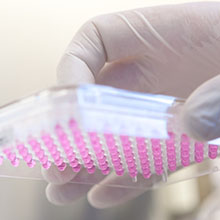New 3D test system for breast cancer radiosensitizing drugs

Picture: Hanging Drop System for the production of 3D micro tissue Source: InSphero AG (2014)
The team of researchers led by Dr. Nataša Anastasov, head of the research group ‘Personalized Radiation Therapy’ at the Institute of Radiation Biology, created multicellular three-dimensional spheroids containing a mix of breast cancer cells and connective tissue cells.
As Anastasov explained, “In conventional cell culture, cell growth is two dimensional, which does not adequately reproduce the characteristics of a tumor in the living organism.” Using the new screening system, the scientists can treat the cancer cells both with various chemical compounds and with radiation to determine the effects – and that in 3D.
In their study the researchers collaborated closely with the ‘Assay Development and Screening Platform’ at Helmholtz Zentrum München and the Munich-based Sirion Biotech GmbH and the Swiss InSphero AG.
The trick: fluorescent cells in hanging drops
“In our system, up to 96 wells containing microtissue spheroids can be simultaneously monitored by a computer,” said co-author Dr. Ines Höfig, explaining the fundamental principle. “For this purpose, the 3D-microtissue spheroids were grown in a hanging drop culture on the underside of a special perforated plate. After a few days, these were transferred onto an assay plate.”
Her colleague Vanja Radulović added: “Because the breast tumor cells and the connective tissue cells have been labeled with different fluorescent markers, they fluoresce in different colors. A software program can thus capture precisely how each of the spheroids reacts to the treatment.”
To confirm their method, the scientists tested the properties of several drugs which are already used in tumor therapy. The drug vinblastine proved to be the most effective in combination with radiation. In the future, the researchers plan to expand their system by adding other components of the tumor environment such as stromal or immune cells in order to optimally simulate the situation in the patient.
Prof. Dr. Michael Atkinson, director of the Institute of Radiation Biology, views the findings of his colleagues with optimism: “For the first time a convenient 3D test for high throughput screening is available with which new drug compounds developed to resensitize tumor cells to radiation treatment can be tested. This will speed up future initiatives for drug development and will also enable the screening of established drugs in combination with radiation.”
Further Information
Background:
The rapid evolution of resistance to both conventional and small molecule therapies is a challenging problem in oncology. One approach to overcome resistance is to use combinatorial treatments that exploit their synergies. The combination of chemotherapy and radiation treatment is a potentially effective combinatorial procedure, although the optimal mix has not been identified. A major drawback in identifying potentially radiation-sensitizing active agents is the lack of high throughput screening (HTS) vehicles. These are needed to replace conventional clonogenic survival assays of radiation treatment as these are too time consuming to operate in a first-pass screening mode. Moreover, there are growing concerns that monolayer and monotypic cellular screening assays may not effectively reproduce the response of a three-dimensional solid tumor to pharmacological compounds.
Original Publication:
Anastasov, N. et al. (2015). A 3D-microtissue-based phenotypic screening of radiation resistant tumor cells with synchronized chemotherapeutic treatment, BMC Cancer, DOI: 10.1186/s12885-015-1481-9
As German Research Center for Environmental Health, Helmholtz Zentrum München pursues the goal of developing personalized medical approaches for the prevention and therapy of major common diseases such as diabetes mellitus and lung diseases. To achieve this, it investigates the interaction of genetics, environmental factors and lifestyle. The Helmholtz Zentrum München has about 2,300 staff members and is headquartered in Neuherberg in the north of Munich. Helmholtz Zentrum München is a member of the Helmholtz Association, a community of 18 scientific-technical and medical-biological research centers with a total of about 37,000 staff members.
The research of the Institute of Radiation Biology (ISB) focuses on understanding the effects of low dose radiation exposure and on studies to increase the effectiveness and specificity of tumor radiotherapy. The research program is carried out by four interlinked research groups. The ISB is part of the Department of Radiation Sciences (DRS).
Contact for the media:
Department of Communication, Helmholtz Zentrum München – German Research Center for Environmental Health (GmbH), Ingolstädter Landstr. 1, 85764 Neuherberg – Phone: +49-(0)89-3187-2238 – Fax: +49 89-3187-3324 – Email: presse@helmholtz-muenchen.de
Scientific contact at Helmholtz Zentrum München:
Dr. Nataša Anastasov, Institute of Radiation Biology, Helmholtz Zentrum München – German Research Center for Environmental Health (GmbH), Ingolstädter Landstr. 1, 85764 Neuherberg – Phone: +49-(0)89-3187-3798 – Fax: +49-(0)89-3187-3378 – E-Mail: natasa.anastasov@helmholtz-muenchen.de
http://www.helmholtz-muenchen.de/en/index.html – Website Helmholtz Zentrum München
http://www.helmholtz-muenchen.de/en/isb/index.html – Website Institute of Radiation Biology
http://www.helmholtz-muenchen.de/aktuelles/pressemitteilungen/2015/index.html – Press Releases of the Helmholtz Zentrum München
Media Contact
All latest news from the category: Life Sciences and Chemistry
Articles and reports from the Life Sciences and chemistry area deal with applied and basic research into modern biology, chemistry and human medicine.
Valuable information can be found on a range of life sciences fields including bacteriology, biochemistry, bionics, bioinformatics, biophysics, biotechnology, genetics, geobotany, human biology, marine biology, microbiology, molecular biology, cellular biology, zoology, bioinorganic chemistry, microchemistry and environmental chemistry.
Newest articles

NASA: Mystery of life’s handedness deepens
The mystery of why life uses molecules with specific orientations has deepened with a NASA-funded discovery that RNA — a key molecule thought to have potentially held the instructions for…

What are the effects of historic lithium mining on water quality?
Study reveals low levels of common contaminants but high levels of other elements in waters associated with an abandoned lithium mine. Lithium ore and mining waste from a historic lithium…

Quantum-inspired design boosts efficiency of heat-to-electricity conversion
Rice engineers take unconventional route to improving thermophotovoltaic systems. Researchers at Rice University have found a new way to improve a key element of thermophotovoltaic (TPV) systems, which convert heat…



